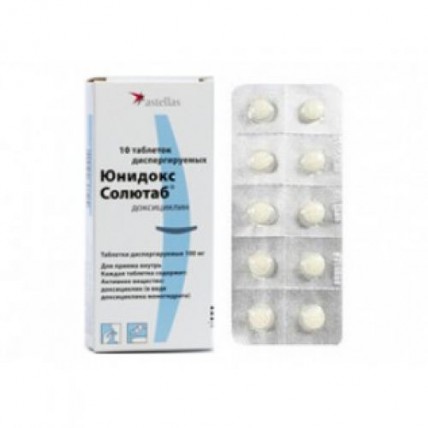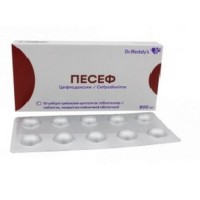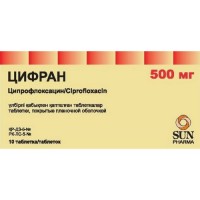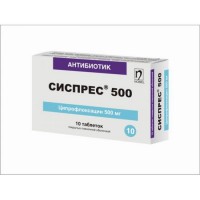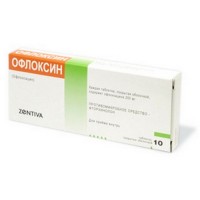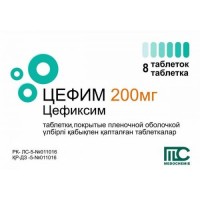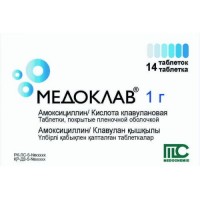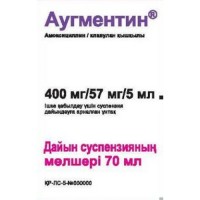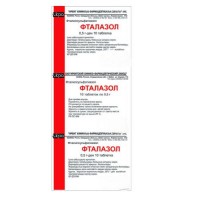JUnidoks Solutab 100 mg (10 tablets)
- $19.30
The instruction for medical use
of Solyutab® Unidoks medicine
the Trade name
of Unidoks Solyutab®
the International unlicensed
name Doxycycline Dosage Form
of the Tablet the dispersed 100 mg
Structure
One tablet contains
active agent - doxycycline of 100 mg (in the form of doxycycline of monohydrate of 105.8 mg),
excipients: microcrystalline cellulose, saccharin, gipromelloza, silicon dioxide colloidal anhydrous, magnesium stearate, lactoses monohydrate.
The description
Round, biconvex tablets from light yellow or gray-yellow color to brown with impregnations, with an engraving 173 on one party and risky on another
Pharmacotherapeutic group
Antibacterial drugs for system use. Tetracyclines. Doxycycline
the ATX J01AA02 Code
The pharmacological
Pharmacokinetics Absorption Absorption properties - fast and high (about 100%). Meal slightly influences drug absorption.
The maximum level of doxycycline in blood plasma (2.6-3 mkg/ml) is reached in 2 h after reception of 200 mg, in 24 h the concentration of active agent in blood plasma decreases to 1.5 mkg/ml.
After reception of 200 mg in the first day of treatment and 100 mg a day in the next days the level of concentration of doxycycline in blood plasma is 1.5-3 mkg/ml.
Distribution
Docsitsiklin reversibly contacts proteins of plasma (80-90%), well gets into bodies and fabrics, it is bad – in cerebrospinal fluid (10-20% of level in blood plasma), however concentration of doxycycline in cerebrospinal fluid increases at inflammation of a spinal cover.
Distribution volume - 1.58 l/kg. In 30–45 minutes after intake, doxycycline is found in therapeutic concentration in a liver, kidneys, lungs, a spleen, bones, teeth, a prostate, eye tissues, in pleural and ascitic liquids, bile, synovial exudate, exudate of Highmore's and frontal sinuses, in liquid of gingival furrows.
At normal function of a liver the drug level in bile is 5-10 times higher, than in plasma.
In saliva 5-27% of the size of concentration of doxycycline in blood plasma are defined.
Doxycycline gets through a placental barrier, in small amounts cosecretes in breast milk.
Collects in dentine and a bone tissue.
Metabolism
Is metabolized an insignificant part of doxycycline.
Removal
Elimination half-life after single dose inside makes 16-18 h, after reception of repeated doses – 22-23 h.
About 40% of the taken drug are excreted by kidneys and 20 - 40% are removed through intestines in the form of inactive forms (chelates).
The pharmacokinetics in special clinical cases
Elimination half-life of drug at patients with renal failures does not change since its excretion through intestines increases.
The hemodialysis and peritoneal dialysis do not affect concentration of doxycycline in blood plasma.
A pharmacodynamics
the Antibiotic of a broad spectrum of activity from group of tetracyclines. Works bacteriostatically, suppresses synthesis of protein in a microbic cell by interaction with 30S a subunit of ribosomes. It is active concerning many gram-positive and gram-negative microorganisms: Streptococcus spp., Treponema spp., Staphylococcus spp., Klebsiella spp., Enterobacter spp. (including E. aerugenes), Neisseria gonorrhoeae, Neisseria meningitidis, Haemophilus influenzae, Chlamydia spp., Mycoplasma spp., Ureaplasma urealyticum, Listeria monocytogenes, Rickettsia spp., Typhus exanthematicus, Escherichia coli, Shigella spp., Campylobacter fetus, Vibrio cholerae, Yersinia spp. (including Yersinia pestis), Brucella spp., Francisella tularensis, Bacillus anthracis, Bartonella bacilliformis, Pasteurella multocida, Borrelia recurrentis, Clostridium spp. (except Clostridium difficile), Actinomyces spp., Fusobacterium fusiforme, Calymmatobacterium granulomatosis, Propionibacterium acnes, some protozoa (Entamoeba spp., Plasmodium falciparum).
As a rule, does not affect Acinetobacter spp., Proteus spp., Pseudomonas spp., Serratia spp., Providencia spp., Enterococcus spp.
It is necessary to take into account a possibility of the acquired doxycycline resistance at a number of activators which often is cross in group (i.e. the strains resistant to doxycycline, at the same time will be resistant to all group of tetracyclines).
Indications
the Infectious and inflammatory diseases caused by microorganisms, sensitive to drug:
- respiratory infection (including LOR-infections)
- infections of an urinogenital system, including infections, sexually transmitted: uncomplicated gonorrhea, not a gonococcal urethritis and syphilis at patients with intolerance of penicillin and cephalosporins
- digestive tract infections
- infections of skin and soft tissues
- infections of eyes, in particular trachoma
the Route of administration and doses
Usually duration of treatment makes 5-10 days. Tablets dissolve in a small amount of water (about 20 ml) with receiving suspension, it is also possible to swallow entirely, to divide into parts or to chew, washing down with water. It is preferable to accept at meal time.
To adults and children 8 years with body weight more than 50 kg are more senior appoint 200 mg in 1-2 receptions in the first day of treatment, further on 100 mg daily. In cases of heavy infections of Unidoks Solyutab® appoint in a dose 200 mg daily during all course of treatment.
Children are 8-12 years old with body weight less than 50 kg an average daily dose – 4 mg/kg in the first day, further – on 2 mg/kg a day (in 1-2 receptions). In cases of heavy infections of Unidoks Solyutab® appoint in a dose 4 mg/kg daily during all course of treatment.
In gonorrhea at men appoint 200 mg – 300 mg within 2 - 4 days or on 300 mg in 2 receptions once a day (the second reception in 1 h after the first).
In gonorrhea at women appoint 200 mg within 5 days once a day (before disappearance of symptoms of an infection).
In primary and secondary syphilis appoint 300 mg within 10 days once a day.
In uncomplicated urogenital infections, the caused Chlamydia trachomatis, a cervicitis, not gonococcal urethritis, the caused Ureaplasma urealiticum, appoint 100 mg 2 times a day within 7 days.
At Typhus exanthematicus - depending on weight of an infection on 100 – 200 mg once. The maximum daily doses for adults - up to 300 mg/days or up to 600 mg/days within 5 days in heavy gonococcal infections. For children 8 years with body weight more than 50 kg – to 200 mg, for children of 8-12 years with body weight less than 50 kg – 4 mg/kg daily during all treatment are more senior. In the presence of renal (kliriyens creatinine less than 60 ml/min.) and/or a liver failure decrease in a daily dose of doxycycline as at the same time there is its gradual accumulation in an organism (risk of hepatotoxic action) is required.
Side effects
- anorexia, nausea, vomiting, a dysphagy, diarrhea, a coloenteritis, pseudomembranous colitis
- urticaria, a photosensitization, a Quincke's disease, anaphylactic reactions, aggravation of a system lupus erythematosus, makulopapulezny and erythematic rash, a pericarditis, exfoliative dermatitis, a multiformny exudative erythema, a generalized dieback, asthma
- damage of a liver (at long administration of drug or at patients with a renal or liver failure), pancreatitis
- the increase in residual nitrogen of urea caused by anti-anabolic effect of drug, nephrotoxic defeat, an anury, an acute renal failure
- hemolytic anemia, thrombocytopenia, a neutropenia, an eosinophilia, decrease of the activity of a prothrombin, toxic granularity of granulocytes, disturbance of blood clotting, a leukocytosis, a leukopenia, a lymphopenia
- benign increase in intracranial pressure (anorexia, vomiting, a headache, hypostasis of an optic nerve, short-sightedness), vestibular disturbances (dizziness or instability), parasthesias, tachycardia, myalgia, an arthralgia, concern, fear
- a reversible dark brown prokrashivaniye of tissue of thyroid gland (at prolonged use)
- delay of bone formation, disturbance of normal development of teeth in children
- candidiasis (stomatitis, a glossitis, a proctitis, a vaginitis) as manifestation of superinfection
- a hamaturia
- phototoxic reactions with change of nails (separation of a nail from a nail bed, discoloration of a nail plate)
of the Contraindication
- hypersensitivity to tetracyclines
- pregnancy and the period of a lactation
- children's age up to 8 years
- heavy abnormal liver functions and/or kidneys
- a porphyria
- hereditary intolerance of fructose, glucose galactose malabsorption, deficiency of Lapp-lactases enzyme
Medicinal interactions
the Antacids (containing aluminum, magnesium, calcium), iron preparations, Natrii hydrocarbonas, magnesium - the containing laxatives reduce doxycycline absorption therefore their use has to be divided by an interval of 3 h
Due to the suppression by drug of intestinal microflora the prothrombin ratio decreases that demands dose adjustment of indirect anticoagulants.
At a combination to the bactericidal antibiotics breaking synthesis of a cell wall (penicillin, cephalosporins), the efficiency of the last decreases.
Drug reduces reliability of contraception and increases the frequency of acyclic bleedings at reception estrogen - the containing hormonal contraceptives.
Ethanol, barbiturates, rifampicin, carbamazepine, Phenytoinum, etc. stimulators of microsomal oxidation, accelerating Unidoks's metabolism Solyutaba®, reduce its concentration in blood plasma.
Simultaneous use with Retinolum, can cause increase in intracranial pressure.
Special instructions
there Is a possibility of cross stability and hypersensitivity with other drugs of a tetracycline row.
Tetracyclines can increase a prothrombin time, prescribing of tetracyclines at patients with coagulopathies has to be controlled carefully.
The anti-anabolic effect of tetracyclines can lead to increase in level of residual nitrogen of urea in blood. As a rule, it has no essential value for patients with normal function of kidneys. However at patients with a renal failure the increase of an azotemia can be observed. Use of tetracyclines for patients with a renal failure demands medical control.
At prolonged use of drug the periodic control of laboratory indicators of blood, function of a liver and kidneys is required.
Due to the possible development of a photodermatitis the restriction of insolation is necessary during treatment and within 4-5 days after its termination.
Reception of antibiotics can cause the excess growth of insensitive organisms, including sort Candida mushrooms. In this case it is necessary to stop administration of drug and to begin the adjusting therapy.
At reception of Unidoks Solyutab® there is a risk of developing pseudomembranous colitis. Its severity can vary from easy to a life-threatening state. It is important to mean this diagnosis at patients with the diarrhea which developed against the background of or after administration of drug. Careful collecting the anamnesis as the diarrhea caused by Clostridium difficile can develop within 2 months after the end of intake of antibacterial drugs is necessary.
Myasthenia gravis (Myasthenia gravis): owing to a possibility of development of neuro and muscular blockade, patients should show care when prescribing tetracyclines with this disease.
System lupus erythematosus: tetracyclines can cause aggravation of a system lupus erythematosus.
For prevention of the dispeptic phenomena it is recommended to take the drug at meal time.
In order to avoid development of an esophagitis or an ulcer of a gullet it is necessary to take the drug washing down with a large amount of water and to avoid administration of drug before going to bed.
Influence of drug on ability to run motor transport and other potentially dangerous mechanisms
Considering a possibility of development of such side effects as dizziness, it is necessary to be careful during the driving and work with moving mechanisms.
Overdose
Symptoms: strengthening of the side reactions caused by injury of a liver – vomiting, a feverish condition, jaundice, an azotemia, increase in level of transaminases, increase in a prothrombin time.
Treatment: right after reception of high doses recommend gastric lavage, plentiful drink, if necessary - induction of vomiting. Accept activated carbon and osmotic laxatives. The hemodialysis and peritoneal dialysis is not recommended in view of low efficiency.
A form of release and packing
On 10 tablets in blister strip packaging from a film of polyvinylchloride and aluminum foil.
On 1 blister strip packaging together with the instruction for medical use in the state and Russian languages place in a pack cardboard.
To Store storage conditions at a temperature not above 25 °C.
To store out of children's reach!
Not to use a period of storage of 5 years after an expiration date.
Prescription status
According to the prescription
the Producer Astellas of Pharm B.V. Europe, Silviusveg 62, 2333 VE, Leiden, Netherlands
the Owner of the registration certificate
Astellas of Pharm B.V. Europe,
the Address of the organization accepting in the territory of the Republic of Kazakhstan claims from consumers on quality of products
Representative office Astellas of Pharm B.V. Europe in RK
Almaty, Al-Farabi Ave. 15, the Centre Party of Finland of Nurla Tau the building 4B. office 20
ph.: +7 (727) 311-13-90, fax: +7 (727) 311-13-89
To develop the Netherlands
of Solyutab® Unidoks medicine
the Trade name
of Unidoks Solyutab®
the International unlicensed
name Doxycycline Dosage Form
of the Tablet the dispersed 100 mg
Structure
One tablet contains
active agent - doxycycline of 100 mg (in the form of doxycycline of monohydrate of 105.8 mg),
excipients: microcrystalline cellulose, saccharin, gipromelloza, silicon dioxide colloidal anhydrous, magnesium stearate, lactoses monohydrate.
The description
Round, biconvex tablets from light yellow or gray-yellow color to brown with impregnations, with an engraving 173 on one party and risky on another
Pharmacotherapeutic group
Antibacterial drugs for system use. Tetracyclines. Doxycycline
the ATX J01AA02 Code
The pharmacological
Pharmacokinetics Absorption Absorption properties - fast and high (about 100%). Meal slightly influences drug absorption.
The maximum level of doxycycline in blood plasma (2.6-3 mkg/ml) is reached in 2 h after reception of 200 mg, in 24 h the concentration of active agent in blood plasma decreases to 1.5 mkg/ml.
After reception of 200 mg in the first day of treatment and 100 mg a day in the next days the level of concentration of doxycycline in blood plasma is 1.5-3 mkg/ml.
Distribution
Docsitsiklin reversibly contacts proteins of plasma (80-90%), well gets into bodies and fabrics, it is bad – in cerebrospinal fluid (10-20% of level in blood plasma), however concentration of doxycycline in cerebrospinal fluid increases at inflammation of a spinal cover.
Distribution volume - 1.58 l/kg. In 30–45 minutes after intake, doxycycline is found in therapeutic concentration in a liver, kidneys, lungs, a spleen, bones, teeth, a prostate, eye tissues, in pleural and ascitic liquids, bile, synovial exudate, exudate of Highmore's and frontal sinuses, in liquid of gingival furrows.
At normal function of a liver the drug level in bile is 5-10 times higher, than in plasma.
In saliva 5-27% of the size of concentration of doxycycline in blood plasma are defined.
Doxycycline gets through a placental barrier, in small amounts cosecretes in breast milk.
Collects in dentine and a bone tissue.
Metabolism
Is metabolized an insignificant part of doxycycline.
Removal
Elimination half-life after single dose inside makes 16-18 h, after reception of repeated doses – 22-23 h.
About 40% of the taken drug are excreted by kidneys and 20 - 40% are removed through intestines in the form of inactive forms (chelates).
The pharmacokinetics in special clinical cases
Elimination half-life of drug at patients with renal failures does not change since its excretion through intestines increases.
The hemodialysis and peritoneal dialysis do not affect concentration of doxycycline in blood plasma.
A pharmacodynamics
the Antibiotic of a broad spectrum of activity from group of tetracyclines. Works bacteriostatically, suppresses synthesis of protein in a microbic cell by interaction with 30S a subunit of ribosomes. It is active concerning many gram-positive and gram-negative microorganisms: Streptococcus spp., Treponema spp., Staphylococcus spp., Klebsiella spp., Enterobacter spp. (including E. aerugenes), Neisseria gonorrhoeae, Neisseria meningitidis, Haemophilus influenzae, Chlamydia spp., Mycoplasma spp., Ureaplasma urealyticum, Listeria monocytogenes, Rickettsia spp., Typhus exanthematicus, Escherichia coli, Shigella spp., Campylobacter fetus, Vibrio cholerae, Yersinia spp. (including Yersinia pestis), Brucella spp., Francisella tularensis, Bacillus anthracis, Bartonella bacilliformis, Pasteurella multocida, Borrelia recurrentis, Clostridium spp. (except Clostridium difficile), Actinomyces spp., Fusobacterium fusiforme, Calymmatobacterium granulomatosis, Propionibacterium acnes, some protozoa (Entamoeba spp., Plasmodium falciparum).
As a rule, does not affect Acinetobacter spp., Proteus spp., Pseudomonas spp., Serratia spp., Providencia spp., Enterococcus spp.
It is necessary to take into account a possibility of the acquired doxycycline resistance at a number of activators which often is cross in group (i.e. the strains resistant to doxycycline, at the same time will be resistant to all group of tetracyclines).
Indications
the Infectious and inflammatory diseases caused by microorganisms, sensitive to drug:
- respiratory infection (including LOR-infections)
- infections of an urinogenital system, including infections, sexually transmitted: uncomplicated gonorrhea, not a gonococcal urethritis and syphilis at patients with intolerance of penicillin and cephalosporins
- digestive tract infections
- infections of skin and soft tissues
- infections of eyes, in particular trachoma
the Route of administration and doses
Usually duration of treatment makes 5-10 days. Tablets dissolve in a small amount of water (about 20 ml) with receiving suspension, it is also possible to swallow entirely, to divide into parts or to chew, washing down with water. It is preferable to accept at meal time.
To adults and children 8 years with body weight more than 50 kg are more senior appoint 200 mg in 1-2 receptions in the first day of treatment, further on 100 mg daily. In cases of heavy infections of Unidoks Solyutab® appoint in a dose 200 mg daily during all course of treatment.
Children are 8-12 years old with body weight less than 50 kg an average daily dose – 4 mg/kg in the first day, further – on 2 mg/kg a day (in 1-2 receptions). In cases of heavy infections of Unidoks Solyutab® appoint in a dose 4 mg/kg daily during all course of treatment.
In gonorrhea at men appoint 200 mg – 300 mg within 2 - 4 days or on 300 mg in 2 receptions once a day (the second reception in 1 h after the first).
In gonorrhea at women appoint 200 mg within 5 days once a day (before disappearance of symptoms of an infection).
In primary and secondary syphilis appoint 300 mg within 10 days once a day.
In uncomplicated urogenital infections, the caused Chlamydia trachomatis, a cervicitis, not gonococcal urethritis, the caused Ureaplasma urealiticum, appoint 100 mg 2 times a day within 7 days.
At Typhus exanthematicus - depending on weight of an infection on 100 – 200 mg once. The maximum daily doses for adults - up to 300 mg/days or up to 600 mg/days within 5 days in heavy gonococcal infections. For children 8 years with body weight more than 50 kg – to 200 mg, for children of 8-12 years with body weight less than 50 kg – 4 mg/kg daily during all treatment are more senior. In the presence of renal (kliriyens creatinine less than 60 ml/min.) and/or a liver failure decrease in a daily dose of doxycycline as at the same time there is its gradual accumulation in an organism (risk of hepatotoxic action) is required.
Side effects
- anorexia, nausea, vomiting, a dysphagy, diarrhea, a coloenteritis, pseudomembranous colitis
- urticaria, a photosensitization, a Quincke's disease, anaphylactic reactions, aggravation of a system lupus erythematosus, makulopapulezny and erythematic rash, a pericarditis, exfoliative dermatitis, a multiformny exudative erythema, a generalized dieback, asthma
- damage of a liver (at long administration of drug or at patients with a renal or liver failure), pancreatitis
- the increase in residual nitrogen of urea caused by anti-anabolic effect of drug, nephrotoxic defeat, an anury, an acute renal failure
- hemolytic anemia, thrombocytopenia, a neutropenia, an eosinophilia, decrease of the activity of a prothrombin, toxic granularity of granulocytes, disturbance of blood clotting, a leukocytosis, a leukopenia, a lymphopenia
- benign increase in intracranial pressure (anorexia, vomiting, a headache, hypostasis of an optic nerve, short-sightedness), vestibular disturbances (dizziness or instability), parasthesias, tachycardia, myalgia, an arthralgia, concern, fear
- a reversible dark brown prokrashivaniye of tissue of thyroid gland (at prolonged use)
- delay of bone formation, disturbance of normal development of teeth in children
- candidiasis (stomatitis, a glossitis, a proctitis, a vaginitis) as manifestation of superinfection
- a hamaturia
- phototoxic reactions with change of nails (separation of a nail from a nail bed, discoloration of a nail plate)
of the Contraindication
- hypersensitivity to tetracyclines
- pregnancy and the period of a lactation
- children's age up to 8 years
- heavy abnormal liver functions and/or kidneys
- a porphyria
- hereditary intolerance of fructose, glucose galactose malabsorption, deficiency of Lapp-lactases enzyme
Medicinal interactions
the Antacids (containing aluminum, magnesium, calcium), iron preparations, Natrii hydrocarbonas, magnesium - the containing laxatives reduce doxycycline absorption therefore their use has to be divided by an interval of 3 h
Due to the suppression by drug of intestinal microflora the prothrombin ratio decreases that demands dose adjustment of indirect anticoagulants.
At a combination to the bactericidal antibiotics breaking synthesis of a cell wall (penicillin, cephalosporins), the efficiency of the last decreases.
Drug reduces reliability of contraception and increases the frequency of acyclic bleedings at reception estrogen - the containing hormonal contraceptives.
Ethanol, barbiturates, rifampicin, carbamazepine, Phenytoinum, etc. stimulators of microsomal oxidation, accelerating Unidoks's metabolism Solyutaba®, reduce its concentration in blood plasma.
Simultaneous use with Retinolum, can cause increase in intracranial pressure.
Special instructions
there Is a possibility of cross stability and hypersensitivity with other drugs of a tetracycline row.
Tetracyclines can increase a prothrombin time, prescribing of tetracyclines at patients with coagulopathies has to be controlled carefully.
The anti-anabolic effect of tetracyclines can lead to increase in level of residual nitrogen of urea in blood. As a rule, it has no essential value for patients with normal function of kidneys. However at patients with a renal failure the increase of an azotemia can be observed. Use of tetracyclines for patients with a renal failure demands medical control.
At prolonged use of drug the periodic control of laboratory indicators of blood, function of a liver and kidneys is required.
Due to the possible development of a photodermatitis the restriction of insolation is necessary during treatment and within 4-5 days after its termination.
Reception of antibiotics can cause the excess growth of insensitive organisms, including sort Candida mushrooms. In this case it is necessary to stop administration of drug and to begin the adjusting therapy.
At reception of Unidoks Solyutab® there is a risk of developing pseudomembranous colitis. Its severity can vary from easy to a life-threatening state. It is important to mean this diagnosis at patients with the diarrhea which developed against the background of or after administration of drug. Careful collecting the anamnesis as the diarrhea caused by Clostridium difficile can develop within 2 months after the end of intake of antibacterial drugs is necessary.
Myasthenia gravis (Myasthenia gravis): owing to a possibility of development of neuro and muscular blockade, patients should show care when prescribing tetracyclines with this disease.
System lupus erythematosus: tetracyclines can cause aggravation of a system lupus erythematosus.
For prevention of the dispeptic phenomena it is recommended to take the drug at meal time.
In order to avoid development of an esophagitis or an ulcer of a gullet it is necessary to take the drug washing down with a large amount of water and to avoid administration of drug before going to bed.
Influence of drug on ability to run motor transport and other potentially dangerous mechanisms
Considering a possibility of development of such side effects as dizziness, it is necessary to be careful during the driving and work with moving mechanisms.
Overdose
Symptoms: strengthening of the side reactions caused by injury of a liver – vomiting, a feverish condition, jaundice, an azotemia, increase in level of transaminases, increase in a prothrombin time.
Treatment: right after reception of high doses recommend gastric lavage, plentiful drink, if necessary - induction of vomiting. Accept activated carbon and osmotic laxatives. The hemodialysis and peritoneal dialysis is not recommended in view of low efficiency.
A form of release and packing
On 10 tablets in blister strip packaging from a film of polyvinylchloride and aluminum foil.
On 1 blister strip packaging together with the instruction for medical use in the state and Russian languages place in a pack cardboard.
To Store storage conditions at a temperature not above 25 °C.
To store out of children's reach!
Not to use a period of storage of 5 years after an expiration date.
Prescription status
According to the prescription
the Producer Astellas of Pharm B.V. Europe, Silviusveg 62, 2333 VE, Leiden, Netherlands
the Owner of the registration certificate
Astellas of Pharm B.V. Europe,
the Address of the organization accepting in the territory of the Republic of Kazakhstan claims from consumers on quality of products
Representative office Astellas of Pharm B.V. Europe in RK
Almaty, Al-Farabi Ave. 15, the Centre Party of Finland of Nurla Tau the building 4B. office 20
ph.: +7 (727) 311-13-90, fax: +7 (727) 311-13-89
To develop the Netherlands
